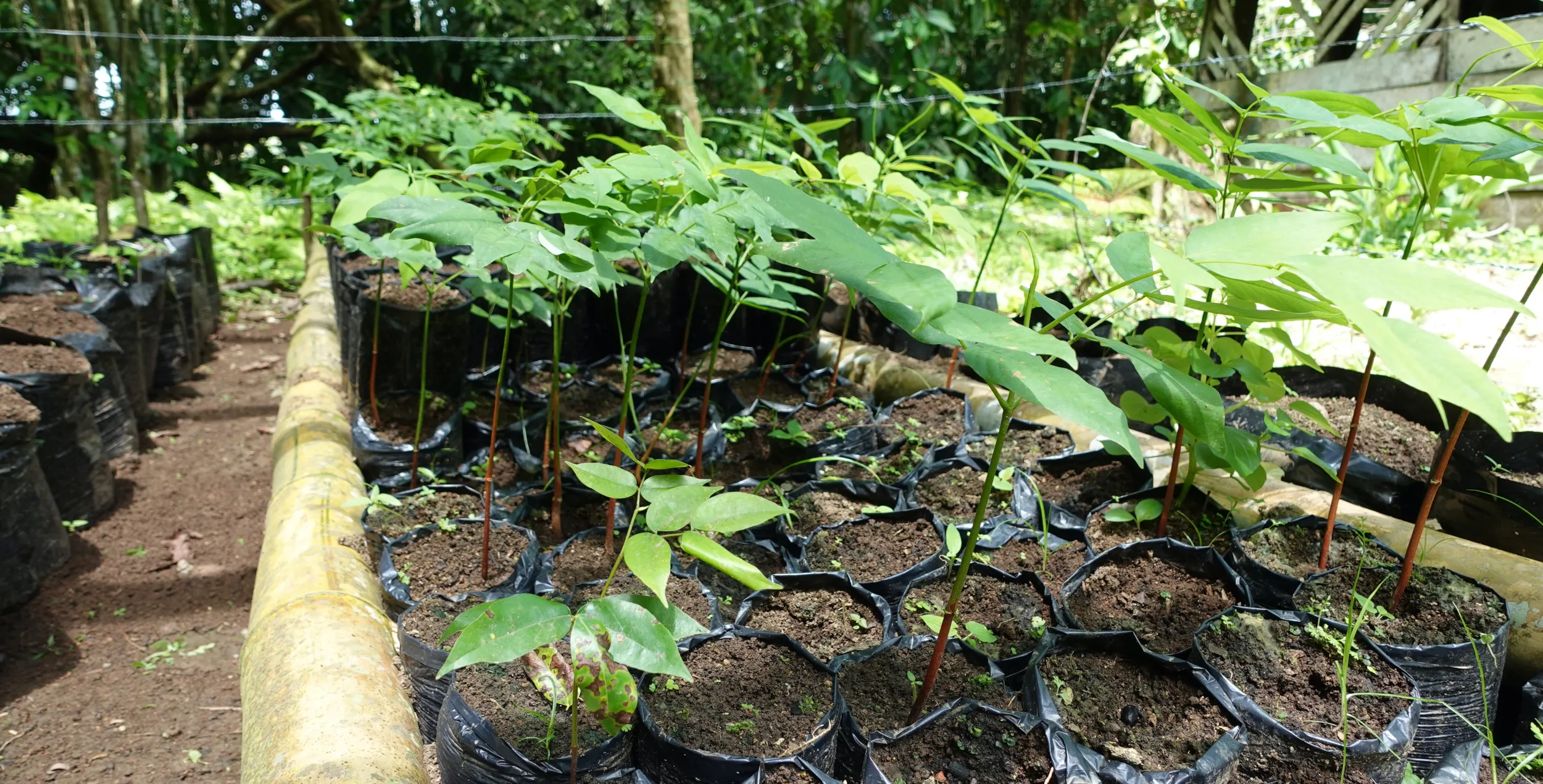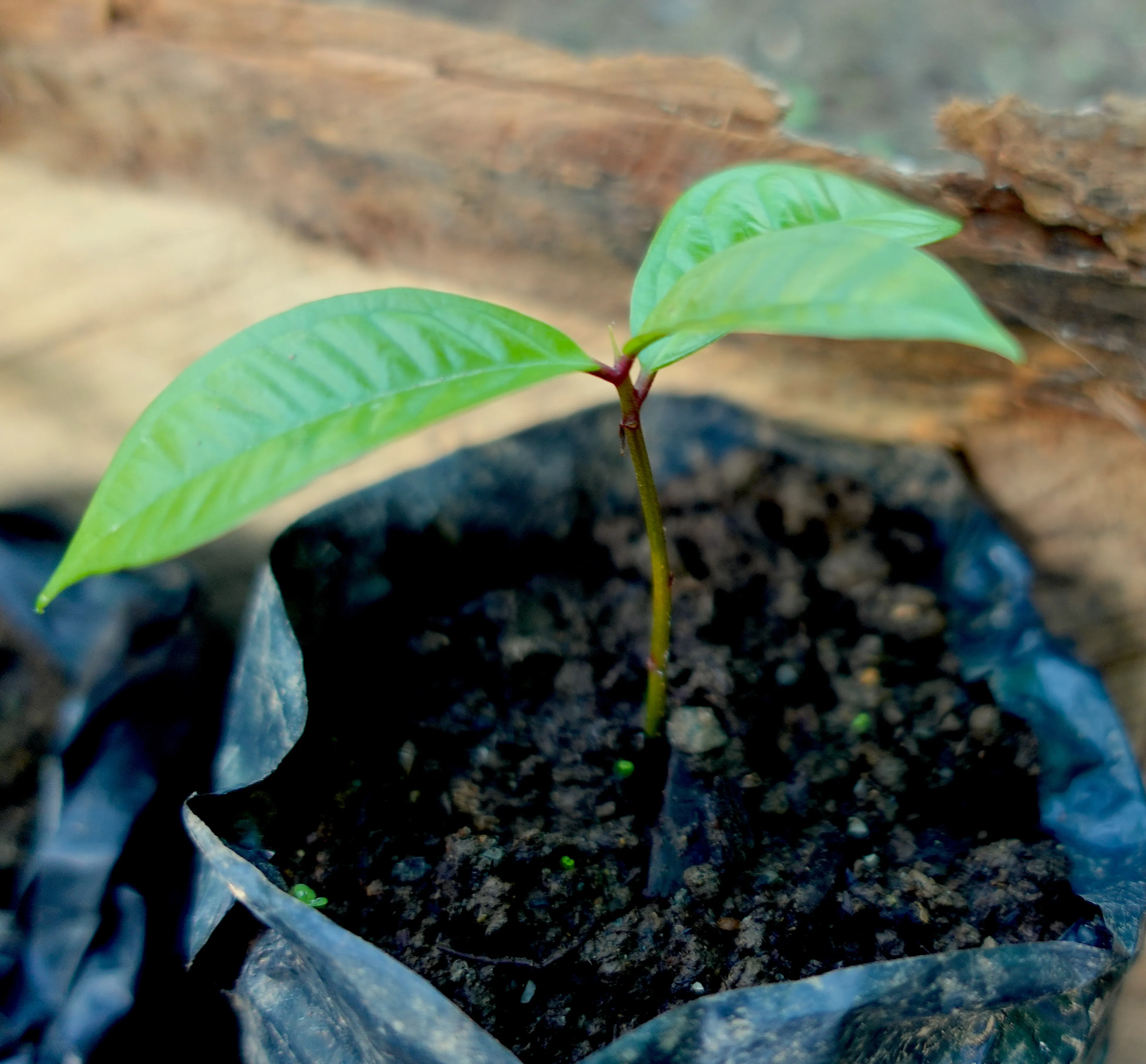About Our Goals
I) We Plant and Care for Endangered Species
Because rare rainforest trees no longer spread on their own
The rainforest of this region (Darién-Chocó) is one of the most biodiverse habitats worldwide (more about the biodiversity hotspot). However, the harsh reality of deforestation poses a severe threat to this region’s ecosystems. The offspring of more heavily exploited species are often found in remote and hard-to-reach places where mother trees still exist and provide seeds. Only a few shoots survive under mother trees, and only if the mother tree dies in time and makes room for a young one. Only the strongest survive.
We search for and rescue some of these endangered tree species’ seeds and young seedlings. Some specimens also grow on pastures. There, herbicides represent the most significant threat. Therefore, we must act promptly. Sometimes, we succeed in being in the right place at the right time.
So far, we sow or plant the seeds or seedlings (under conditions adapted to their needs) in our sowing bags or nursery beds if the shoots allow for later selection and transplanting. There will also be tree islands for some species in the future; more on this in our Tree Island newsletter.
We look for safe places with suitable soil properties for our mature seedlings and tree islands to grow and produce flowers, fruits, and seeds. With the help of wind, water currents, bats, and birds, their seeds can spread again. With some luck, trees may grow and mature over time, and the cycle will continue. Additionally, our protégés, with their seeds and seedlings, can provide genetic material for reforestation projects.
II) We Plant ALTERNATIVE TIMBER SPECIES
Adequate protection for endangered species must provide the region’s people with meaningful alternatives for constructing their homes and fences
The Chocó-Darién region is geographically delimited by the Caribbean coast and the Gulf of Urabá (in the northeast), the Atrato River and an adjacent rainforest area (in the south), and the Darién mountain range with the border to Panama (in the west) like an island “in front of” the “Colombian mainland.”
This explains, on the one hand, the - now endangered - abundance of endemic species but also hampers work and trade in the region. The only significant legal source of income is livestock farming. Building materials such as concrete and steel are expensive, and their procurement is logistically demanding; therefore, many houses and pasture fence posts are still made of wood. Rather than harvesting regionally or globally endangered species for this purpose, the region should have greater availability of alternative species that are equally suitable for the task and can grow faster. Among them are tree species that serve as living fences, holding the wire fence and providing shade, root systems, and food for animals and soil. These species include Fría and Mataratón; the latter is also used medicinally (e.g., mosquito protection).
III) We Plant MANY DIFFERENT TYPES OF FRUIT TREES
Because fruits and homemade juices are healthier for humans and the environment than colorful sodas in plastic bottles with long transport routes; additionally, they serve as a food source for animal species that are vital as pollinators and seed spreaders for the conservation of endangered trees
Fruit trees have shorter life cycles. They are also more susceptible to pests, and in the region, they had to give way to the space requirements of pastures and buildings. They exist in fewer numbers and less diversity; more replanting needs to be done. The once widely accepted right to pick fruit for a little snack on the go has been increasingly restricted by cutting down trees on pastures, with the argument that fences suffered from pedestrian traffic.
However, people and animals live on limes, mandarins, oranges, avocados, mangoes, guavas, chili, bananas, coconuts, etc. Their consumption helps prevent diseases or helps to recover from them. Importing fruit into the isolated region (see above) is difficult due to high temperatures, high humidity, rough seas, and high transport costs across the gulf. Plastic bottles filled with over-sugared colorful drinks withstand the journey better. However, local fruit trees offer a cheaper, healthier, plastic-free, and CO2-negative alternative and are therefore essential for people’s and nature’s health in the region. Last but not least, fruit trees provide food for all the animals that can help us pollinate the endangered species and distribute their seeds far and wide.
About Our Work
Small Challenges
Finding the growth conditions for wild rainforest species
- Soil mixture
- General moisture level
- Resistance to waterlogging
- Light requirements
- Tolerance to direct sunlight
- Compatibility with other forest inhabitants (parasites, predators, etc.)
A Minor Point of Ethical Consideration
Plastic in Tree Nurseries
We plant seeds or small seedlings straight into nursery beds to cut down on plastic bags for seedlings. We only use seedling bags for a few highly endangered species and recycle them. To avoid using plastic mesh covers for direct sunlight and rainfall protection, we can plant different species together directly in the soil, where they will grow and protect each other, creating ‘tree islands.’ In our detailed newsletter article, you can learn more about this tree island method and our efforts to reduce plastic.
A Brief Retrospective
How It All Began
In March 2023, we started preparing the first space for a few hundred trees. We sowed over 200 seeds, about a third of which sprouted. In addition, we planted more seeds in another place in the village to experiment with different conditions. However, our nursery was too small. Our first fundraising campaign in June 2023 gave our project a significant step forward: we were able to set up a larger area for several thousand seedlings next to it.
So we now have three tree nurseries: a very small one in the middle of the village, a medium-sized one on the farm, and a slightly larger one next to it. Each one offers varying amounts of sunlight and soil conditions, so we can try out susceptible seeds at all three locations.
Brief Insights into Our Work
-
Regularly clean the nursery grounds and the surrounding area of overgrown underbrush. Not because we advocate English lawns but because we think about our survival here in the tropics and want to keep the workplace free from poisonous snakes, spiders, and scorpions.
-
From different places on the farm, we bring different types of soil and natural fertilizers to the nursery. To do this, we must cross our densely overgrown farm on foot. It is hard work to maneuver all this topsoil and ant dung through rugged terrain. But we are not lacking in motivation; after all, it is the nursery for our babies.
-
In addition, we have to buy seedling bags, fill them with soil, place them in the nursery, and, if necessary, rearrange them or create nursery beds. In both cases, the beds and bags must be maintained, excessive wild growth must be plucked, and the seedlings need protection from predators.
-
In parallel, we regularly check our boundary fences because even the cows from the surrounding pastures already know that we have more tasty greens and always enough fresh water in the streams, especially in the dry season. We understand the cows, but they cause significant damage to the trees on our farm, especially in the nursery.
-
When all these tasks are done or in progress, we can take the most fulfilling step: search for more seeds and shoots, bring them to the nursery, and plant them. Here, we often rely on local guides who can lead us to the last representatives of a species, which also has cost.
-
Caring for the seeds, checking their germination processes, and finding solutions when a species does not thrive requires dedication and a spirit of research. Because for some species, neither the people here nor the internet can provide serious advice.
-
The shoots from the nursery are given a protected place on our farm or another well-secured location.

